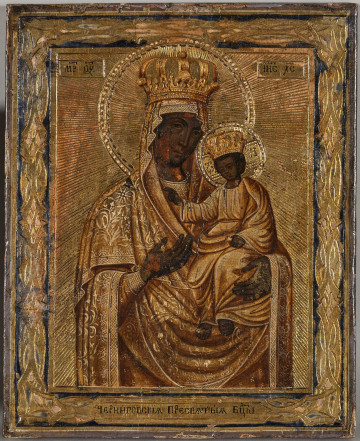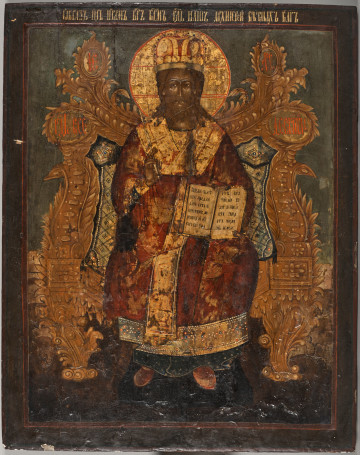
The Mother of God of Hodigitria
19th (?) century
Castle Museum in Łańcut
Part of the collection: Ikony
Icon depicts the monks Savvatus and Zosimus Solovetsky who lived in the 15th century. In 1429, monk Savvatus and his companion German from the monastery on the island of Valaam, searching for seclusion, went to the northern wilderness by the White Sea and set up a hermitage on the mountain called Sekernaya Gora of the Solovetsky islands. They lived in austere conditions for several years devoting themselves to prayer. After Savvatus’ death in 1435, German, looking for a fellow traveller, met Zosimus at the White Sea. He was a young man of plebeian origin from the shores of Lake Onega who, in order to avoid marriage, ran away from his parents’ house and, in search of seclusion and spiritual guidance, lived with German in a hermitage to share with him an ascetic life. Once Zosimus saw in a vision an Orthodox church floating in the air. Perceiving it as a sign from God, he initiated the construction of the church of Transfiguration of Jesus. The temple became the nucleus of the Solovetsky Monastery, which flourished in the 16th–17th centuries. In the middle of the 17th century the monastery located on the Solovetsky Islands resisted the liturgical reform of Patriarch Nikon. Besieged by the tsarist army, the monastery was taken by force in 1676 and the monks were murdered. Since then, saints Zosimus and Savvatus, whose relics rested on the Solovetsky Islands, have been especially venerated by Old Believers opposing the Orthodox reform. Saints Zosimus and Savvatus are recognised as patron saints of the White Sea and of beekeepers, praised in the Orthodox Church on April 30, August 8 and September 27 – respectively April 17, August 21 and October 10 of the Julian calendar. After the revolution of 1917, the Solovetsky monastery was closed down, while its building was used to set up a special Stalinist labour camp for political prisoners, clergy and intelligentsia. In the 1960s a museum was initiated in the monastery, and in 1990 it was returned to the Orthodox Church of the Moscow Patriarchate. Teresa Bagińska-Żurawska https://orcid.org/0000-0002-9243-3967
Dimensions
height: 11 cm, width: 8.7 cm
Object type
Icons
Technique
gilding, tempera
Material
gold, tempera, wood
Origin / acquisition method
decyzja administracyjna
Creation time / dating
Creation / finding place
Owner
Castle Museum in Łańcut
Identification number
Location / status

19th (?) century
Castle Museum in Łańcut

1800 — 1850
Castle Museum in Łańcut

1800 — 1899
Castle Museum in Łańcut
DISCOVER this TOPIC
Castle Museum in Łańcut
DISCOVER this PATH
Educational path